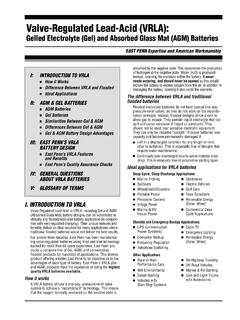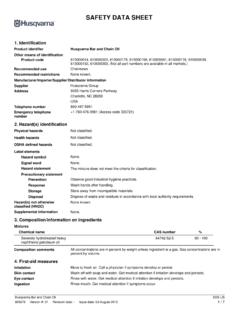Transcription of SAFETY DATA SHEET - East Penn Manufacturing
1 SAFETY data SHEET . 1. Identification Product identifier Lead Acid Battery Wet, Filled With Acid Other means of identification Synonyms may include gel/absorbed electrolyte type lead acid batteries Recommended use Electric storage battery. Recommended restrictions None known. Manufacturer/Importer/Supplier/Distribut or information Manufacturer/Supplier East Penn Manufacturing Company, Inc. Address 102 Deka Road, Lyon Station PA 19536. Telephone number (610) 682-6361. Contact person East Penn EHS Department Emergency telephone USA/Canada: CHEMTREC (800) 424-9300, Outside USA 1 (703) 527-3887. number E-mail 2. Hazard(s) identification Physical hazards Explosive Chemical, Division Health hazards Acute toxicity, oral Category 4. Acute toxicity, inhalation Category 4. Skin corrosion/irritation Category 1A. Serious eye damage/eye irritation Category 1. Carcinogenicity Category 1A. Reproductive toxicity Category 1A. Specific target organ toxicity, single exposure Category 1 (respiratory system).
2 Specific target organ toxicity, single exposure Category 3 respiratory tract irritation Specific target organ toxicity, repeated Category 1 (respiratory system). exposure Environmental hazards Hazardous to the aquatic environment, acute Category 1. hazard Hazardous to the aquatic environment, Category 1. long-term hazard OSHA defined hazards Not classified. Label elements Signal word Danger Hazard statement Harmful if swallowed. Harmful if inhaled. Causes severe skin burns and eye damage. May cause cancer. May damage fertility or the unborn child. Causes damage to organs (respiratory system). Causes damage to organs (respiratory system) through prolonged or repeated exposure. May cause respiratory irritation. Very toxic to aquatic life with long lasting effects. Precautionary statement Prevention Obtain special instructions before use. Do not handle until all SAFETY precautions have been read and understood. Keep away from heat/sparks/open flames/hot surfaces.
3 - No smoking. Do not breathe dust/mist/vapors. Wash thoroughly after handling. Do not eat, drink or smoke when using this product. Use only outdoors or in a well-ventilated area. Avoid release to the environment. Wear protective gloves/protective clothing/eye protection/face protection. Lead Acid Battery Wet, Filled With Acid SDS US. 923330 Version #: 03 Revision date: 28-February-2018 Issue date: 19-September-2017 1/9. Response If swallowed: Rinse mouth. Do NOT induce vomiting. If on skin (or hair): Take off immediately all contaminated clothing. Rinse skin with water/shower. If inhaled: Remove person to fresh air and keep comfortable for breathing. If in eyes: Rinse cautiously with water for several minutes. Remove contact lenses, if present and easy to do. Continue rinsing. Immediately call a poison center/doctor. Wash contaminated clothing before reuse. Collect spillage. Storage Store in a well-ventilated place. Keep container tightly closed.
4 Disposal Refer to manufacturer/supplier for information on recovery/recycling. Dispose of contents/container in accordance with local/regional/national/international regulations. Hazard(s) not otherwise Under normal conditions of processing and use, exposure to the chemical constituents in this classified (HNOC) product is unlikely. The battery should not be opened or burned. Exposure to the ingredients contained within or their combustion products could be harmful. Supplemental information In use, may form flammable/explosive vapor-air mixture. 3. Composition/information on ingredients Mixtures Chemical name CAS number %. Lead and lead compounds 7439-92-1 43 - 70. (inorganic). Electrolyte (Sulfuric acid) 7664-93-9 20 - 44. Antimony 7440-36-0 3-5. Composition comments All concentrations are in percent by weight unless ingredient is a gas. Gas concentrations are in percent by volume. Content composition concentrations will vary with battery type/size.
5 4. First-aid measures Inhalation Exposure to contents of an open or damaged battery: Move injured person into fresh air and keep person under observation. Get medical attention if any discomfort continues. Skin contact Exposure to contents of an open or damaged battery: Immediately flush with plenty of water for at least 15 minutes while removing contaminated clothing and shoes. Get medical attention if irritation develops and persists. Eye contact Exposure to contents of an open or damaged battery: Flush thoroughly with water for at least 15. minutes. Hold eyelids open during flushing. If irritation persists, repeat flushing. Get medical attention if irritation develops and persists. Ingestion Exposure to contents of an open or damaged battery: Rinse mouth thoroughly with water. DO NOT. induce vomiting because of danger of aspirating liquid into lungs. Get medical attention immediately. Most important Under normal conditions of processing and use, exposure to the chemical constituents in this symptoms/effects, acute and product is unlikely.
6 The battery should not be opened or burned. Exposure to the ingredients delayed contained within or their combustion products could be harmful. Heavy lead exposure may result in central nervous system damage, encephalopathy and damage to the blood-forming (hematopoietic) tissues. Indication of immediate Treat symptomatically. medical attention and special treatment needed General information Ensure that medical personnel are aware of the material(s) involved, and take precautions to protect themselves. 5. Fire-fighting measures Suitable extinguishing media Dry chemical, foam, carbon dioxide, water fog. Unsuitable extinguishing Do NOT use water on live electrical circuits. media Specific hazards arising from Batteries evolve flammable hydrogen gas during charging and may increase fire risk. Containers the chemical may explode when heated. Special protective equipment Self-contained breathing apparatus and full protective clothing must be worn in case of fire.
7 And precautions for firefighters Selection of respiratory protection for firefighting: follow the general fire precautions indicated in the workplace. Fire fighting Use standard firefighting procedures and consider the hazards of other involved materials. equipment/instructions General fire hazards Like any sealed container, battery cells may rupture when exposed to excessive heat; this could result in the release of corrosive and flammable materials. Lead Acid Battery Wet, Filled With Acid SDS US. 923330 Version #: 03 Revision date: 28-February-2018 Issue date: 19-September-2017 2/9. 6. Accidental release measures Personal precautions, Avoid contact with skin. protective equipment and emergency procedures Methods and materials for Neutralize the spilled material before disposal. Sweep up or vacuum up spillage and collect in containment and cleaning up suitable container for disposal. Dispose of waste and residues in accordance with local authority requirements.
8 Environmental precautions Prevent runoff from entering drains, sewers, or streams. 7. Handling and storage Precautions for safe handling In the event of damage resulting in a leak of exposed materials, avoid contact with contents of an open or damaged cell or battery. Keep away from heat, sparks and open flame. Do not allow conductive material to touch the battery terminals. A dangerous short-circuit may occur and cause battery failure and fire. Conditions for safe storage, Store in original tightly closed container. Protect containers from damage. Place cardboard including any incompatibilities between layers of stacked batteries to avoid damage and short circuits. 8. Exposure controls/personal protection Occupational exposure limits US. OSHA Specifically Regulated Substances (29 CFR ). Components Type Value Lead and lead compounds TWA mg/m3. (inorganic) (CAS. 7439-92-1). US. OSHA Table Z-1 Limits for Air Contaminants (29 CFR ).
9 Components Type Value Antimony (CAS 7440-36-0) PEL mg/m3. Electrolyte (Sulfuric acid) PEL 1 mg/m3. (CAS 7664-93-9). US. ACGIH Threshold Limit Values Components Type Value Form Antimony (CAS 7440-36-0) TWA mg/m3. Electrolyte (Sulfuric acid) TWA mg/m3 Thoracic fraction. (CAS 7664-93-9). Lead and lead compounds TWA mg/m3. (inorganic) (CAS. 7439-92-1). US. NIOSH: Pocket Guide to Chemical Hazards Components Type Value Antimony (CAS 7440-36-0) TWA mg/m3. Electrolyte (Sulfuric acid) TWA 1 mg/m3. (CAS 7664-93-9). Lead and lead compounds TWA mg/m3. (inorganic) (CAS. 7439-92-1). Biological limit values No biological exposure limits noted for the ingredient(s). ACGIH Biological Exposure Indices Components Value Determinant Specimen Sampling Time Lead and lead compounds 200 g/l Lead Blood *. (inorganic) (CAS. 7439-92-1). * - For sampling details, please see the source document. Appropriate engineering Provide adequate ventilation. Provide easy access to water supply and eye wash facilities.
10 Controls Individual protection measures, such as personal protective equipment Eye/face protection None under normal conditions. Leak from a damaged or opened battery: Wear SAFETY glasses with side shields (or goggles). Lead Acid Battery Wet, Filled With Acid SDS US. 923330 Version #: 03 Revision date: 28-February-2018 Issue date: 19-September-2017 3/9. Skin protection Hand protection None under normal conditions. Leak from a damaged or opened battery: Wear appropriate chemical resistant gloves. Skin protection Other None under normal conditions. Leak from a damaged or opened battery: Wear suitable protective clothing. Use of an impervious apron is recommended. Respiratory protection None under normal conditions. Thermal hazards When material is heated, wear gloves to protect against thermal burns. General hygiene Always observe good personal hygiene measures, such as washing after handling the material considerations and before eating, drinking, and/or smoking.





